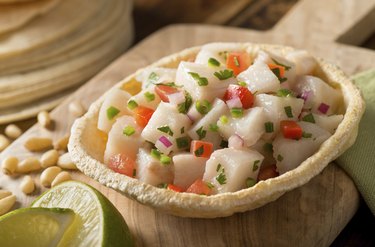Things You'll Need
Commercially frozen saltwater white fish
Knife
Covered glass bowl
Lemons or lemon juice
Onions
Salt
Chopped vegetables
Olive oil, hot sauce, sugar or vinegar
Slotted spoon
Cocktail glasses
Cilantro, parsley or avocado slices

Lemon juice is a very acidic liquid that you can use to "cook" your fish without the use of heat, creating a dish called ceviche that is common in Central and South America. The acid in the lemon juice chemically denatures the proteins in your fish, similar to the way that the proteins are denatured when heated. Because the acid won't kill all the harmful microorganisms in the fish, though, some people should never consume food prepared this way. If you do, use fish that's been commercially frozen in temperatures below 0 degree Fahrenheit to make your ceviche.
Step 1
Remove the skin, bones and blood line from your fish once you have defrosted it. While you can use any fish to create ceviche, saltwater white fish like sea bass, mahi mahi, flounder and grouper work best. These types of fish have a semi-firm texture and light flavor, which will "cook" well with the lemon juice.
Video of the Day
Step 2
Chop your fish into small cubes, around an inch in size, and place them in a glass bowl. Lemon juice will denature small pieces of the fish more evenly than larger ones, and impart some tangy flavor to them.
Step 3
Squeeze several lemons to make enough juice to cover your fish. Fresh juice gives the fish the nicest flavor but you can also use bottled juice, which is slightly more acidic and may cook your fish a little faster.
Step 4
Dice a few onions to add to the fish. The onion will become softer when marinated in the lemon juice, and will impart a pleasant flavor into the fish.
Step 5
Cover the fish in lemon juice and sprinkle some salt on the fish for flavor.
Step 6
Marinate the fish in the lemon juice for at least 30 minutes and up to 6 hours, in a covered bowl. Place the bowl in the refrigerator at 40 degrees F, or lower.
Step 7
Check the fish after 30 minutes to an hour to see if it's ready, as some types of fish may denature more quickly than others, and can become mushy if marinated too long. The flesh of the fish should be white, firm and opaque.
Step 8
Add chopped vegetables, like red or green peppers, tomatoes or hot chili peppers, 10 to 30 minutes before you serve the fish. While you can marinate these veggies with the fish the entire time, they tend to lose their vibrant colors and crunchy textures.
Step 9
Mix in some olive oil, hot sauce, sugar or vinegar to further flavor the fish before serving.
Step 10
Serve the dish, using a slotted spoon, in cocktail glasses to your guests; garnish with a little cilantro, parsley or some avocado slices.
Tip
Ceviche only lasts about a day in the refrigerator at 40 F or below.
Warning
Use commercially frozen fish to make your ceviche because your freezer isn't cold enough to kill most harmful microorganisms, which are killed in fish frozen at 31 F below zero for at least 24 hours, recommends the Seafood Health Facts website.
Even ceviche made with commercially frozen fish may still contain harmful microorganisms, which can affect those with weakened immune systems and pregnant women, warns the U.S. Food and Drug Administration.
Only use a glass or plastic bowl to marinate the fish because metal will react with the acids in the lemon juice.
Video of the Day
- The Washington Post: The Acid Test
- U.S. Food and Drug Administration: Fresh and Frozen Seafood: Selecting and Serving It Safely
- The Guardian: How to Make Perfect Ceviche
- Seafood Health Facts: Seafood Safety
- Science and Food: Ceviche
- North Carolina State University: Celebrate with Safe Salsa
- National Center for Home Food Preparation: Ingredients for Salsa Recipes
- EatByDate: Shelf Life of Fish
- The Huffingon Post: How to Make the Perfect Ceviche, and Common Mistakes to Avoid
- The Christian Scientist Monitor: Ceviche: All You Need Is Raw Fish, Lime Juice, and Patience